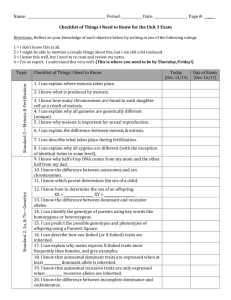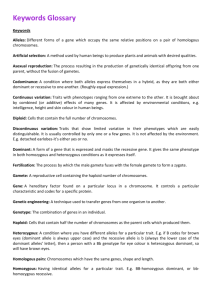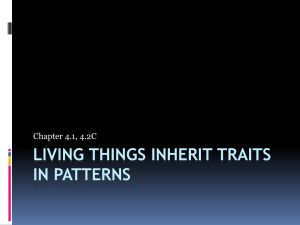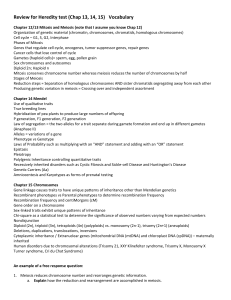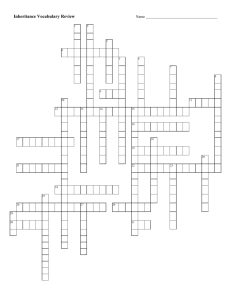Ch. 6 & 7 Quiz Bio Recovery
advertisement
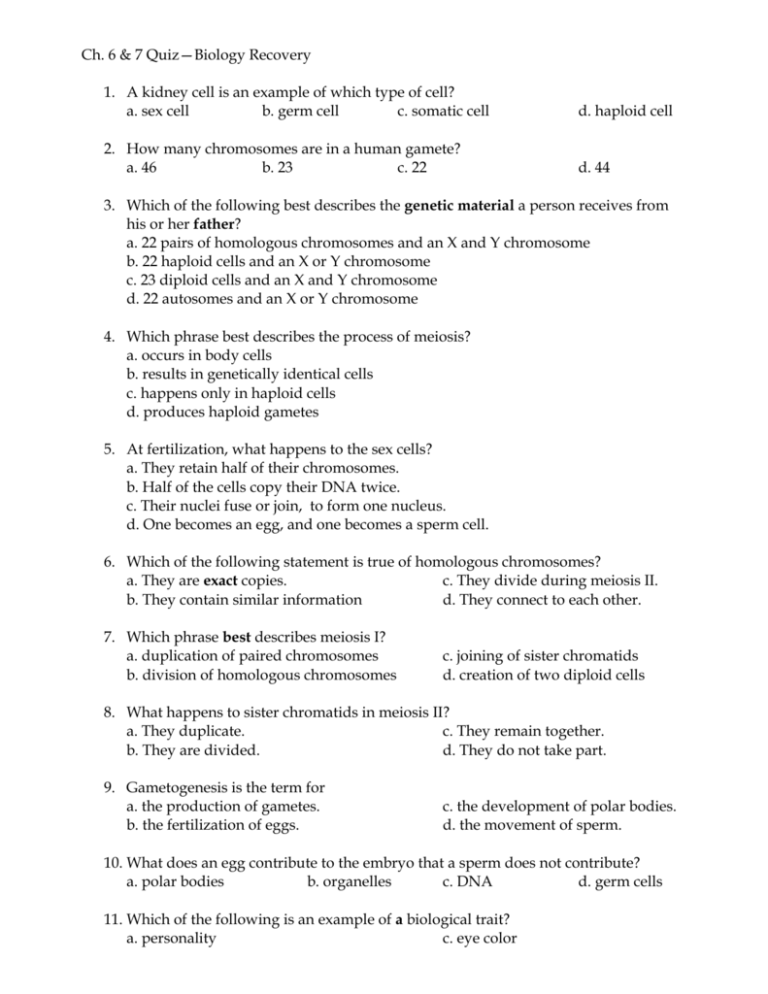
Ch. 6 & 7 Quiz—Biology Recovery 1. A kidney cell is an example of which type of cell? a. sex cell b. germ cell c. somatic cell d. haploid cell 2. How many chromosomes are in a human gamete? a. 46 b. 23 c. 22 d. 44 3. Which of the following best describes the genetic material a person receives from his or her father? a. 22 pairs of homologous chromosomes and an X and Y chromosome b. 22 haploid cells and an X or Y chromosome c. 23 diploid cells and an X and Y chromosome d. 22 autosomes and an X or Y chromosome 4. Which phrase best describes the process of meiosis? a. occurs in body cells b. results in genetically identical cells c. happens only in haploid cells d. produces haploid gametes 5. At fertilization, what happens to the sex cells? a. They retain half of their chromosomes. b. Half of the cells copy their DNA twice. c. Their nuclei fuse or join, to form one nucleus. d. One becomes an egg, and one becomes a sperm cell. 6. Which of the following statement is true of homologous chromosomes? a. They are exact copies. c. They divide during meiosis II. b. They contain similar information d. They connect to each other. 7. Which phrase best describes meiosis I? a. duplication of paired chromosomes b. division of homologous chromosomes c. joining of sister chromatids d. creation of two diploid cells 8. What happens to sister chromatids in meiosis II? a. They duplicate. c. They remain together. b. They are divided. d. They do not take part. 9. Gametogenesis is the term for a. the production of gametes. b. the fertilization of eggs. c. the development of polar bodies. d. the movement of sperm. 10. What does an egg contribute to the embryo that a sperm does not contribute? a. polar bodies b. organelles c. DNA d. germ cells 11. Which of the following is an example of a biological trait? a. personality c. eye color b. hair style d. regional accent 12. Hair color and eye color are examples of a person’s a. recessive traits. c. genotype. b. dominant alleles. d. phenotype. 13. When Mendel crossed plants that were purebred purple-flowered with plants that were purebred white-flowered, the resulting offspring all had purple flowers. When allowed to self-pollinate, this generation gave rise to white-flowered plants as well as purple. As a result, Mendel determined that individual traits are: a. inherited as discrete units. c. diluted in offspring. b. merged with successive generations. d. lost in the pollination process. 14. Mendel was able to identify predictable patterns of heredity. He succeeded mainly because he chose to study traits that a. were always dominant. c. could be diluted. b. tended to be recessive. d. had only two forms. 15. When an organism has two alleles at a particular locus that are different, the organism is called a. purebred. c. heterozygous. b. dominant. d. recessive. 16. If a pea plant were homozygous recessive for height, how would its alleles be represented? a. Tt b. TT c. tt d. tT 17. An allele is dominant in a heterozygote when it is a. expressed and the other allele is not. b. a very common allele in a population. c. more desirable than the other allele. 18. What do the letters inside the grid of a Punnett square represent? a. phenotypes of parents c. testcrosses of offspring b. genotypes of offspring d. chromosomes of parents 19. What is the probability that the offspring of a cross between a homozygous recessive parent and a heterozygous parent will be homozygous recessive? a. 1/1 b. 1/2 c. 1/4 d. 1/8 20. The term for a cross that involves just one trait, such as pod shape, is called a a. homozygous cross. c. monohybrid cross. b. test cross. d. dihybrid cross. 21. What is the phenotypic ratio of a monohybrid cross between two heterozygous parents? a. 3:1 b. 1:2:1 c. 9:3:3:1 d. 1:2:2:1 22. Which of the following observations did Mendel make as a result of his experiments with dihybrid crosses? a. Dominant traits are inherited together. b. Different traits are inherited separately. c. Similar traits are inherited in pairs. d. Recessive traits are inherited unpredictably. 23. Which phrase best describes the process of crossing over? a. Pairs of homologous chromosomes exchange segments. b. Pairs of sister chromatids exchange segments. c. Pairs of homologous chromosomes become linked. d. Pairs of sister chromatids become linked. 24. Suppose a gene that codes for flower color is linked with a gene that codes for leaf shape. Which statement is true of this pair of genes? a. They have similar loci on homologous chromosomes. b. They cross over separately during recombination. c. They are close together on the same chromosome. d. They likely will be inherited separately. 25. During what stage of meiosis does crossing over occur? a. prophase I of meiosis I c. telophase I of meiosis I b. anaphase II of meiosis II d. metaphase II of meiosis II 26. A person who is heterozygous for a disorder caused by recessive alleles is a carrier of the disorder. A carrier is a person who a. does not have the disorder but can pass it on to offspring. b. can develop the disorder later in life but cannot pass it on. c. has a dominant normal allele that has been inactivated. d. passes the disorder to offspring on the Y chromosome only. 27. Genes that are located on sex chromosomes are called a. alleles. b. recessive. c. XY. d. sex-linked. 28. Unlike the traits studied by Mendel, most traits are produced by genes with a. sex linkage. c. dominance and recessiveness. b. only one allele. d. multiple alleles. 29. A plant that is homozygous for red flowers is crossed with a plant that is homozygous for white flowers. In the case of incomplete dominance, the flowers of the offspring will be a. red and white. b. white only. c. pink only. d. red only. 30. In the case of codominant alleles, a plant that is homozygous for red flowers that is crossed with a plant that is homozygous for white flowers will produce flowers that are a. red and white spotted. c. dark pink all over. b. completely white. d. pink and red. 31. Eye color, hair color, and skin color are polygenic traits. Polygenic traits result from a. recessive genes. c. codominant genes. b. many genes. d. epistatic genes. 32. Identical twins who are raised apart can have differences that last a lifetime. This is evidence that a. phenotype differences happen through epistatic genes. b. genotype can change over time. c. environment and genotype interact to affect phenotype. d. codominance affects genotype. 33. Which observation of Morgan’s is evidence that crossing over occurs? a. Linked genes are sometimes inherited separately. b. Some dominant traits are always inherited together. c. Inheritance of gene combinations is not random. d. Fruit flies have only two groups of linked traits. 34. Two genes on a given chromosome that are most likely to be inherited together are a. 6.8 map units apart. c. 2 map units apart. b. 10 map units apart. d. 18.5 map units apart. 35. What is the main difference between the carrier of a sex-linked disorder and the carrier of an autosomal disorder? a. Female carriers of an autosomal disorder pass the disorder to all offspring. b. All carriers of autosomal disorders have two dominant alleles for the disorder. c. The carrier of a sex-linked disorder is always female but does not have the disorder. d. Male carriers of a sex-linked disorder always have mothers who had the disorder. 36. A chart that traces the phenotypes and genotypes within a family is called a a. pedigree. c. Punnett square. b. karyotype. d. chromosome map. 37. A genetic disorder is traced within a family. The disorder occurs mostly in males. The gene for this disorder is most likely a. not sex-linked. b. on the X chromosome. c. an autosomal allele. d. carried only by males. 38. Which of the following types of genetic information can be identified easily with a karyotype? a. homologous chromosomes b. dominant traits c. exact locations of genes d. recessive alleles For each of the following crosses – complete a punnett square. State the parent genotypes. State the genotypic ratio AND phenotypic ratio of the resulting offspring. 39. Cross a Heterozygous Tall plant with a short plant. (tall is dominant to short). 40. Cross a Homozygous Tall plant with a Heterozygous tall plant. 41. Cross a Heterozygous Tall plant with a heterozygous tall plant. 42. In the above crosses – explain where the results of meiosis are found. 43. In a paragraph: Explain how the process of meiosis produces variation in a population of organisms. Explain why that is important for the survival of a species.

